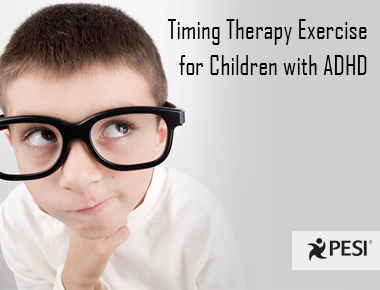The Timing Therapy Exercise Every Therapist Needs

Timing and synchronization are crucial to our brain's ability to function. Our brain has a master clock and circuitry devoted to keeping cells and signals synchronized. When the timing of this circuitry is imprecise, brain processes can suffer and we experience a degradation of motor skills, senses, cognitive skills, emotional regulation and other functions.
Timing therapy is an approach to re-syncing the brain's timing circuits. Research has shown that when we regularly practice timing precision, we can repair out-of-sync timing circuitry in the brain, which in turn increases brain and body functionality in a significant way.
Key elements of timing therapy include:
The beat: It should match the natural rhythm of the activity.
The tempo: A comfortable clapping speed for most people is about 54 beats per minute (BPM). However, a typical child with ADHD will be more comfortable at a slightly higher tempo (try 63 BPM).
Precision: Keeping an imprecise beat or not caring about the beat will not produce desired results.
Feedback: The most powerful forms of timing therapy provide sensory feedback on how well the beat is being maintained.
Much of the research in timing therapy has been done in conjunction with the Interactive Metronome. Studies show that children with ADHD who did 15 hours of tapping and clapping exercises using the Interactive Metronome made 30% gains in their executive-function skills. This includes attention skills, working memory, motivation ability to plan and problem-solve, as well as the ability to stay organized.
Want to implement timing therapy with your clients and see similar results, but don't have the funding to purchase equipment? Teresa Garland, MOT, OTR has a method for you. By combining a metronome and a ball, you can get the same sensory feedback for under $2.
This blog is based on the writing of Teresa Garland, MOT, OTR. Check out her award winning book Self-Regulation Interventions and Strategies: Keeping the Body, Mind & Emotions on Task in Children with Autism, ADHD or Sensory Disorders.
Timing therapy is an approach to re-syncing the brain's timing circuits. Research has shown that when we regularly practice timing precision, we can repair out-of-sync timing circuitry in the brain, which in turn increases brain and body functionality in a significant way.
Key elements of timing therapy include:
The beat: It should match the natural rhythm of the activity.
The tempo: A comfortable clapping speed for most people is about 54 beats per minute (BPM). However, a typical child with ADHD will be more comfortable at a slightly higher tempo (try 63 BPM).
Precision: Keeping an imprecise beat or not caring about the beat will not produce desired results.
Feedback: The most powerful forms of timing therapy provide sensory feedback on how well the beat is being maintained.
Much of the research in timing therapy has been done in conjunction with the Interactive Metronome. Studies show that children with ADHD who did 15 hours of tapping and clapping exercises using the Interactive Metronome made 30% gains in their executive-function skills. This includes attention skills, working memory, motivation ability to plan and problem-solve, as well as the ability to stay organized.
Want to implement timing therapy with your clients and see similar results, but don't have the funding to purchase equipment? Teresa Garland, MOT, OTR has a method for you. By combining a metronome and a ball, you can get the same sensory feedback for under $2.
Master the simple method in under four minutes.
 |
This blog is based on the writing of Teresa Garland, MOT, OTR. Check out her award winning book Self-Regulation Interventions and Strategies: Keeping the Body, Mind & Emotions on Task in Children with Autism, ADHD or Sensory Disorders.


